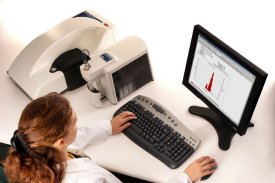The work of Dr Sindra Peterson Årsköld, Associate Professor, and her colleagues at Lund University's (Sweden) proton channel group, focuses on liposomal investigations of viral proteins and anti-viral agents. The liposomes are used as artificial models of the virion, enabling systematic scrutiny of key membrane-bound drug targets.
Dr Peterson Årsköld believes that, because her research depends on accurate, routine sample quality control in a wide range of sample conditions, it would not be feasible without the rapid, reliable, resource-efficient measurement capabilities of the Zetasizer Nano particle characterization system from Malvern Panalytical.

Dr Peterson Årsköld explains why the cost of sample characterization is so critical to her work as a protein scientist; "Created by sonicating phospholipids in water, the liposomes produced are used to obtain highly detailed, quantitative biophysical data. It is therefore of utmost importance that each batch holds the same high quality, in terms of narrow size distribution and unilamellarity, and that their morphology is reproducible and consistent. Monitoring these parameters is also pivotal in developing the method of liposome production and optimizing it for new protein systems. For example, some conditions will result in multilamellar liposomes, which have many layers like an onion. This means that every time we produce a new sample we must carry out a quality check to ensure the process is consistent."
"While electron microscopy (EM) provides us with more detailed data, it takes a whole day to obtain the images. It would therefore be costly to use EM for routine sample testing. Dynamic light scattering (DLS) with the Zetasizer Nano is both non-destructive and fast. It enables us to walk up to the instrument and test our samples in a matter of minutes," said Dr Peterson Årsköld. "In fact, it is such a useful, easy-to-use system that the protein chemists in my department have used it every day since I bought it and wouldn't want to live without it now they have it!"
Part of Lund University's Department of Biochemistry and Structural Biology, Dr Peterson Årsköld and the proton channel group have been studying the behavior of the M2 protein, a small, single-span transmembrane (TM) protein from the influenza A virus. A paper co-authored by Dr Peterson Årsköld and published in the July issue of the Proceedings of the National Academy of Sciences (PNAS), uncovers the mysterious process that enables multiple protons to invade the influenza A virus, triggering infection of the host cell, without developing a large electrical potential. Results demonstrate the remarkably complex, functionally tuned pH-dependence of the M2 protein, providing a better chance of developing successful antiviral drugs. For more information on the work of the proton channel group and other molecular and protein research at Lund University visit: http://www.cmps.lu.se/